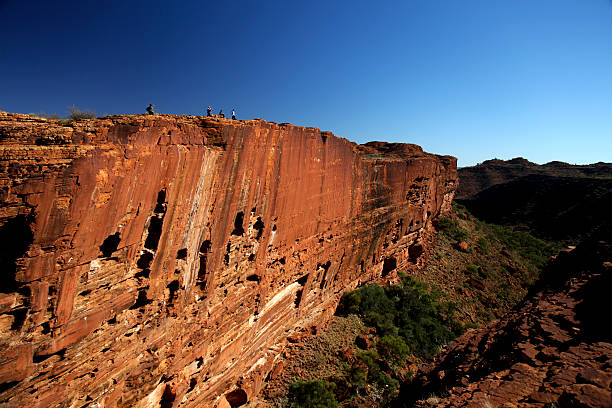Nestled in the heart of the Australian Outback, Kings Canyon Discovery Park is a treasure trove of rugged landscapes, steep cliffs, and dense foliage. This natural wonder offers visitors the unique opportunity to immerse themselves in awe-inspiring geological formations and a serene ambiance far removed from the buzz of the city life. In this article, we dive deep into the park, sharing insider tips on the best activities, how to arrive from Uluru to Kings Canyon, and what makes this destination a must-visit for adventurers and nature lovers alike.
Planning Your Visit to Kings Canyon Discovery Park

Embarking on a journey to Kings Canyon requires some preparation. As you plan your visit, consider visiting between April and September, when the temperatures are most favorable. The drive from Uluru to Kings Canyon is approximately a 3 to 4-hour journey by car through some of Australia’s most iconic red desert landscapes. Before you set off, make sure you have your park permits arranged, as they are essential for entry and can be purchased upon arrival or at various outlets in nearby towns.
Table 1: Travel Details from Uluru to Kings Canyon
| Mode of Transportation | Duration | Notes |
|---|---|---|
| Car | 3-4 hours | Check for road closures during wet seasons |
| Guided Tours | Varies | Includes stops at attractions |
| Public Transport | Not available | Best to rent a car or join a tour |
Must-See Attractions at Kings Canyon Discovery Park
Kings Canyon is brimming with breathtaking landmarks, and no visit is complete without seeing them. The Rim Walk is arguably the most famous hike that takes you along the top of the canyon where you are treated to incredible panoramic views. For a tranquil escape, the Garden of Eden is a lush watering hole, perfect for moments of reflection, while Kathleen Springs invites you on an easy track leading to a picturesque spring-fed waterhole.
- The Rim Walk – A captivating 6km circuit that ascends to the top of the canyon and loops around its rim.
- The Garden of Eden – A hidden valley and waterhole that offers a serene pit-stop amidst the hike.
- Kathleen Springs – Accessible to all visitors, this gentle walk ends at a scenic spring that has a fascinating cultural history.
Hiking and Outdoor Activities at Kings Canyon
The park’s vast expanse invites all manner of outdoor enthusiasts to partake in its many trails and activities. Trail lengths vary, catering to different fitness levels and interests. To guarantee a safe and enjoyable experience, it’s essential to carry adequate water, wear sun protection and sturdy footwear, and stay informed about the weather and trail conditions. Let’s look closer at some of the most popular trails within Kings Canyon.
Hiking Trails and Difficulty Ratings
- Kings Creek Walk:Easy – A leisurely 2km return walk along the creek bed, suitable for all ages.
- South Wall Return Walk:Moderate – A steeper and more challenging route that rewards hikers with dramatic views of the park.
- Giles Track:Hard – A 22km one-way trek for experienced hikers, offering an in-depth exploration of the park’s landscapes.
Accommodation and Facilities at Kings Canyon Discovery Park
After a long day of exploration, visitors have various accommodation options to choose from. Whether you’re pitching a tent under the stars at one of the park’s campgrounds or indulging in the comfort of the Kings Canyon Resort, there’s a place for every preference and budget. The resort also provides dining options, ranging from buffet-style meals to al fresco dining under the outback sky.
Accommodation Types and Amenities
| Type | Description | Amenities |
|---|---|---|
| Camping | Designated camping areas with basic facilities | Picnic tables, fire pits, restrooms |
| Resort Lodging | Hotel rooms and deluxe accommodations | Pool, restaurant, Wi-Fi (limited) |
| Backcountry Camping | For the adventurous, remote camping within the park | Access to nature’s splendor |
Conclusion
Immerse yourself in the rugged beauty and timeless allure of Kings Canyon Discovery Park to create memories that will last a lifetime. From the challenging Rim Walk to the serene Garden of Eden, this remarkable natural playground offers delights for both the adventure-seeker and the soul-searcher. By respecting the fragile ecosystem and cultural heritage of this enchanting canyon, we ensure its wonders remain for generations to come. Pack your bags, tie your hiking boots, and embark on an Australian Outback adventure unlike any other.
FAQs
Q1: What is the best time of year to visit Kings Canyon Discovery Park?
A1:The best time to visit Kings Canyon Discovery Park is during the cooler months from April to September when the temperatures are more comfortable for hiking and outdoor activities.
Q2: Are there any guided tours available in Kings Canyon Discovery Park?
A2:Yes, there are guided tours available that offer insightful commentary on the geological history, flora, and fauna of the park as well as the cultural significance of the area to the indigenous people.
Q3: Is it possible to visit Kings Canyon Discovery Park without a car?
A3:While it’s more convenient to have a car due to the remote location, there are tour operators that provide transportation to and from the park as a part of their package.
Q4: Can I camp overnight at Kings Canyon Discovery Park?
A4:Yes, you can camp at designated camping areas within the park. It’s important to book in advance, especially during peak tourist season, as spots can fill up quickly.
Q5: Are there any specific safety concerns to be aware of when visiting Kings Canyon Discovery Park?
A5:Visitors should be prepared for the park’s rugged terrain, fluctuating weather conditions, and potential wildlife encounters. It’s essential to carry enough water, wear appropriate clothing, and inform someone of your travel plans if venturing into remote areas. Always stay on marked paths and observe park regulations.
